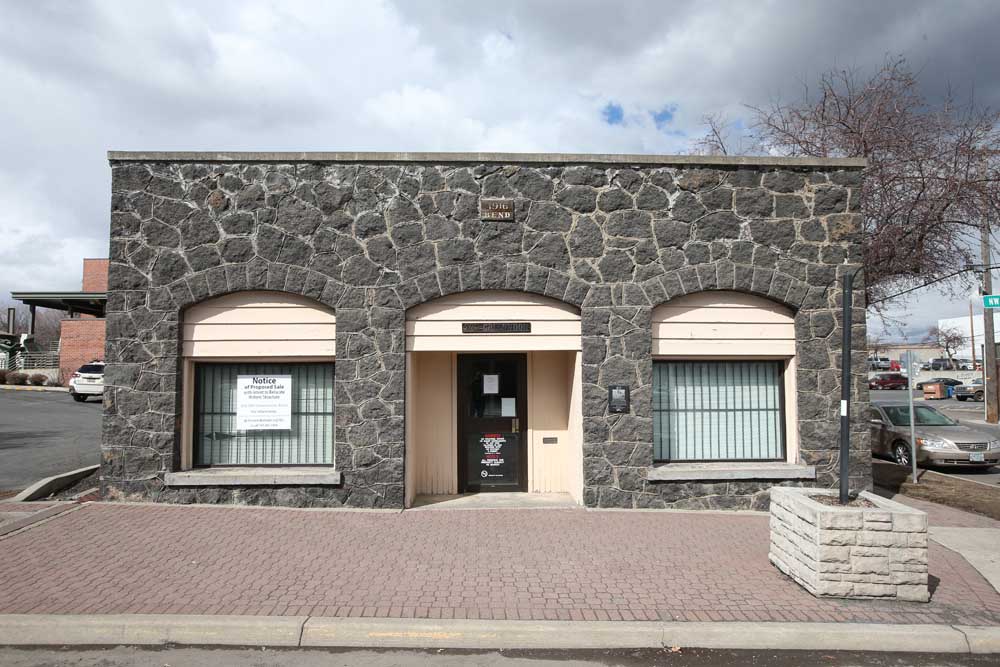Twenty years after historic Crane Shed demolition in Bend, lessons still to be learned
Published 5:45 am Thursday, September 12, 2024

- The A.J. Tucker Building at 202 NW Greenwood Ave., in March 2023. It was razed for the expansion of the Deschutes County Courthouse.
In the summer of 2004, property developers had their eyes on a prime piece of real estate on the northern edge of Bend’s Old Mill District.
There was just one thing in the way of their development plans — a 500-foot-long, 74-foot-tall wooden warehouse known as the Crane Shed, dating from the heyday of Bend’s timber boom.
Trending
No matter. The developers, Crown Investment Group, surreptitiously demolished the massive and historic building in August of that year. The work was done under the cover of darkness and without a demolition permit.
Crown argued that the enormous building — located on land now occupied by Springfield Suites and Crane Shed Commons — was dangerous and needed to be taken down for public safety. Others said more could have been done to preserve the iconic building.
An ‘awesome’ building
The building had no shortage of history connecting it Bend’s rise as a center of the nation’s timber industry. Built in 1937, it featured an interior metal crane that moved lumber around the building. When the lumber mills began to wind down, it was converted into an indoor tennis facility with two courts and was later used by a local beverage distributor.
Annunziata “Nunzie” Gould, a Deschutes County resident active in preserving historic buildings, described the Crane Shed as “awesome.”
“It had beautiful old-growth wood that people would salivate over because of the tightness of the rings,” said Gould. “The crane was supported by wood, those were like 48-inch-tall beams. The (shed) brought distinction to how big the mills were in our town.”
Trending
In the wake of the illegal demolition, a Deschutes County Circuit Court judge fined Crown Investment Group around $100,000. Bend City Manager Eric King said these funds were used to pay for a memorial to the Crane Shed — several bus stops resembling the shed built along Bond Street were the resulting tribute to the building.
Fines were also levied by the Oregon Department of Environmental Quality for the mishandling of asbestos in the building.
Bend also updated codes to create stiffer penalties for unauthorized demolition. Over the years, these codes have been updated and those that exist now are designed to prevent a repeat of the Crane Shed episode.
Aaron Henson, a senior city planner with the city of Bend, worked for the city at the time and was responsible for documenting remnants of the Crane Shed after its demolition.
“I was very sad to see it gone,” said Henson. “It was one of Bend’s biggest, most iconic buildings — very prominent as viewed from atop Pilot Butte or Overturf Butte. I remember my dad’s stories about playing indoor tennis there, back in the early 1980s.”
Buildings still threatened
Two decades after that controversial event, old buildings are still coming down, albeit on a much smaller scale.
Kelly Cannon-Miller, executive director of the Deschutes Historical Museum, highlights a few buildings that have fallen in recent years to make way for development. While not as grand as the Crane Shed, they were architecturally unique.
The Hong Kong Restaurant on Third Street, torn down in 2022, was one such building. The restaurant had a “distinctive type of mid-century architectural styling for Chinese-American restaurants,” said Cannon-Miller.
More recently, the A.J. Tucker Building on Greenwood was razed to the ground, to make way for an expanded courthouse, although its facade stones were saved so that it may one day be rebuilt in some other location.
Cannon-Miller also highlights the leveling of a former Church of the Nazarene on Third Street, a 1950s building torn down in 2020. In its place sprung up a Starbucks and a bank. Cannon-Miller said the property owners missed an opportunity to repurpose the building.
“At the same time (the church) went down for a boring, cookie-cutter strip mall, a similar church in Redmond was being turned into Grace and Hammer (Pizzeria), a business featured in ‘Diners, Drive-Ins and Dives’,” said Cannon-Miller.
The conversion of the one-time church (which served multiple purposes during its life) into a successful restaurant follows a global trend of renovation and repurposing projects, even with buildings as large as the Crane Shed. Examples abound. The Spruce Goose hangar is now office space for Google employees. A disused torpedo factory in Washington, D.C., is now an art museum.
Cannon-Miller worries about other historic buildings in the area, especially those around Greenwood Avenue.
Greenwood is “an area that is on the edge of downtown; it could be in (danger in) the future. As those properties move through time, the eyes of developers will fall on older spaces … for new opportunities,” she said.
Old structures saved
Other buildings beyond Bend could also disappear unless saved by a renovation effort.
In July, the Three Sisters Historical Society issued an appeal to the Sisters City Council to save the historic Conklin House from demolition as part of a project to build a high-end RV Park. And at Paulina Lake, cabins constructed by the Independent Order of Odd Fellows (IOOF) in the 1930s also need renovations before they become unrepairable.
“Throughout the county, there isn’t enough emphasis put on identifying structures as locally significant to our community history,” said Cannon-Miller. “Surveys only look for national significance, and that’s how a lot of sites fall through the cracks.”
“But being listed isn’t enough if the owners of a property aren’t willing to save a structure they own,” she said.
Cannon-Miller says there are plenty of examples around Central Oregon of protecting and repurposing old structures. The brick powerhouse buildings in the Old Mill District, which used to generate electricity to power the mill, became the REI Co-Op, a popular outdoor equipment store, after careful preservation in 2004. On the Santiam Pass, a 1940 ski lodge is under careful renovation with a grassroots effort and small donations.
And right across the road from where the Crane Shed stood is the Box Factory, another structure from the timber days that was successfully converted into retail and restaurant space a decade ago.
“The Box Factory is a living example of what is possible when you save spaces that provide a sense of authenticity and community,” said Cannon-Miller.
Protecting for the future
Gould, the local preservation enthusiast, agrees that more effort needs to be put into restoration rather than demolition.
“The fabric of our community is better served by having these buildings,” she said. “They are important parts of our community that connect our citizens.”
Gould urges private developers and the city of Bend to do more to protect what is left of Bend’s historic footprint.
“People involved in historic preservation respect the value of historic preservation and historic assets. I don’t think the city of Bend or (Deschutes) County has been adding to their list (of protected resources). They have been tearing down the things on their list. It’s time to add sites and buildings to their list and be committed to stewarding community assets,” she said.
Historic Greenwood
Avenue
Several historic buildings are located on Greenwood Avenue in Bend, but receive little fanfare or recognition. They include:
• BendTel (136 NW Greenwood) — Built in 1920, this was the former location of the segregated Black USO Club.
• Midtown Ballrooom & Domino Room (51 NW Greenwood) — Built in 1925, this was a creamery (Bend Dairy) before becoming a roller rink in the 1980s. It is now a concert hall.
• Mid-State Meat Market Co. (37 NW Greenwood) — This 1937 building housed a butcher shop but is no longer used.
Crane Shed facts
The 1937 Crane Shed, 500 feet long and 74 feet tall, was formally known as the Brooks-Scanlon Crane Shed.
The massive building was originally built to store lumber but was later repurposed after the decline of the timber industry — it housed two full-sized tennis courts and was later used by a beverage distributor.
The building is named after a huge crane attached to the ceiling that moved lumber around the shed.
Its existence ended on Aug. 19, 2004, when work crews demolished the building in a single night.








